Imagine yourself transported to a world of castles, flowing gowns, and timeless romance—where every bride embodies the grace of a storybook princess.
33 Enchanting Medieval Wedding Hairstyles for Princesses unveils a treasure trove of hair artistry inspired by centuries past, blending the elegance of historical tradition with modern bridal sophistication.
Whether you dream of braided crowns adorned with delicate flowers, cascading waves framed by jeweled circlets, or intricate updos fit for royalty, this comprehensive guide offers something magical for every bride seeking to channel medieval majesty on her special day.
From the ethereal simplicity of loose, natural styles to the elaborate grandeur of court-inspired arrangements, these hairstyles celebrate the enduring allure of an era when beauty was both art and ceremony.
This article explores 33 distinct medieval-inspired looks, each accompanied by styling insights, historical context, and practical tips to help you create your perfect fairytale moment, ensuring your wedding day transforms into a celebration worthy of queens and legends.
Contents
- 1 1. The Classic Braided Crown
- 2 2. Loose Flowing Waves with Circlet
- 3 3. The Double Braided Half-Up Style
- 4 4. The Waterfall Braid Crown
- 5 5. Medieval Low Bun with Veil
- 6 6. The Side Braid with Flowers
- 7 7. The Twisted Updo with Jeweled Pins
- 8 8. Natural Curls with Floral Crown
- 9 9. The Rope Braid Updo
- 10 10. Half-Up with Cascading Curls
- 11 11. The Milkmaid Braid
- 12 12. Elegant Chignon with Veil Attachment
- 13 13. The Twisted Crown with Loose Ends
- 14 14. Medieval Side Updo with Accessories
- 15 15. The Boho Medieval Braid
- 16 16. High Braided Bun
- 17 17. The Celtic Knot Braid
- 18 18. Loose Low Ponytail with Ribbon
- 19 19. The Crown Braid with Center Part
- 20 20. Textured Low Updo with Accessories
- 21 21. The Half-Crown Braid
- 22 22. Victorian-Medieval Fusion Updo
- 23 23. The Wrapped Braid Bun
- 24 24. Loose Waves with Pearl Headband
- 25 25. The Romantic Side Twist
- 26 26. Medieval Headband Braid
- 27 27. The Twisted Low Chignon
- 28 28. Voluminous Curls with Jeweled Circlet
- 29 29. The Braided Updo with Fresh Flowers
- 30 30. Simple Center Part with Face-Framing Braids
- 31 31. The Ladder Braid Half-Up
- 32 32. Elegant Twisted Ponytail
- 33 33. The Romantic Undone Updo
- 34 Tips for Maintaining Medieval Hairstyles Throughout Your Wedding Day
- 35 Choosing Accessories for Your Medieval Wedding Hairstyle
- 36 Hair Care Leading Up to Your Medieval Wedding
- 37 Working with Your Hairstylist: Communication Tips
- 38 Medieval Hairstyles for Different Hair Types and Textures
- 39 Seasonal Considerations for Medieval Wedding Hairstyles
- 40 Budget-Friendly Medieval Hairstyling Options
- 41 Medieval Hairstyles for Bridesmaids and Wedding Party
- 42 Photography Considerations for Medieval Wedding Hairstyles
- 43 Conclusion
1. The Classic Braided Crown
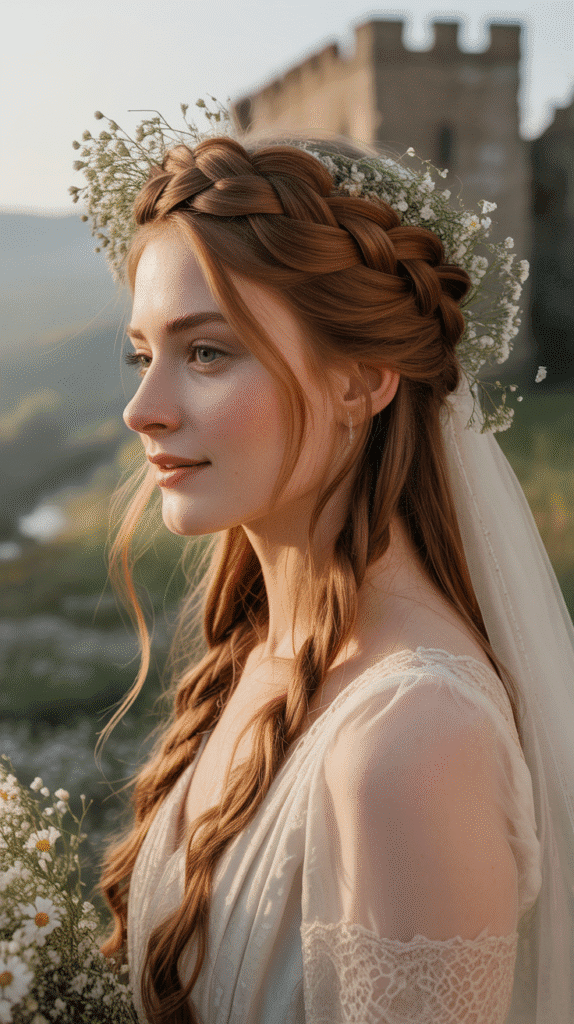
The braided crown stands as one of the most iconic medieval hairstyles, symbolizing both nobility and feminine virtue in historical courts.
This timeless style involves weaving hair into thick braids that encircle the head like a natural diadem, creating an effect that’s both regal and romantic.
Styling Elements:
- The foundation begins with parting hair down the center to create two equal sections for balanced braiding.
- Each section is braided tightly from the nape of the neck, incorporating three-strand or four-strand techniques for added texture and dimension.
- The braids wrap around the head and secure with hidden pins, creating a seamless circular crown effect.
- Small pearl pins or delicate flower buds can be woven throughout the braids for enhanced medieval authenticity.
- This style works exceptionally well for brides with medium to long hair and provides excellent support for veils or additional headpieces.
2. Loose Flowing Waves with Circlet
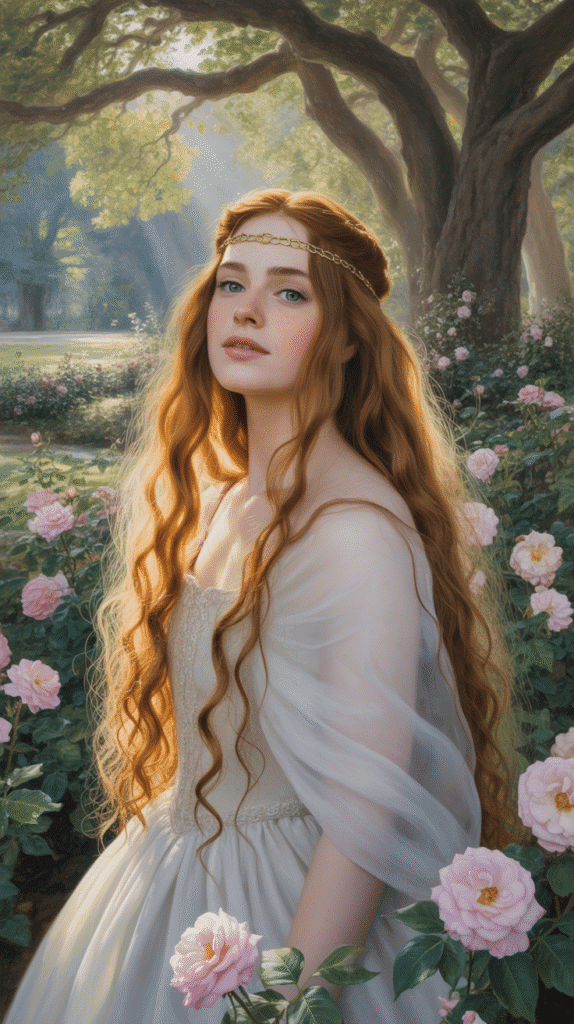
Medieval maidens often wore their hair long and free, symbolizing youth and purity, with simple metal circlets to denote status.
This effortless yet elegant style captures the essence of natural beauty celebrated in medieval times.
Styling Techniques:
- Hair is left predominantly down, allowing natural texture to shine through with gentle enhancement.
- Soft waves are created using large-barrel curling tools or braiding techniques applied to damp hair overnight.
- A metal circlet, whether gold, silver, or adorned with gemstones, sits across the forehead approximately one inch from the hairline.
- The front sections can be lightly pulled back to prevent hair from obscuring the face during ceremony.
- This style pairs beautifully with flowing medieval gowns and creates an ethereal, goddess-like appearance.
3. The Double Braided Half-Up Style
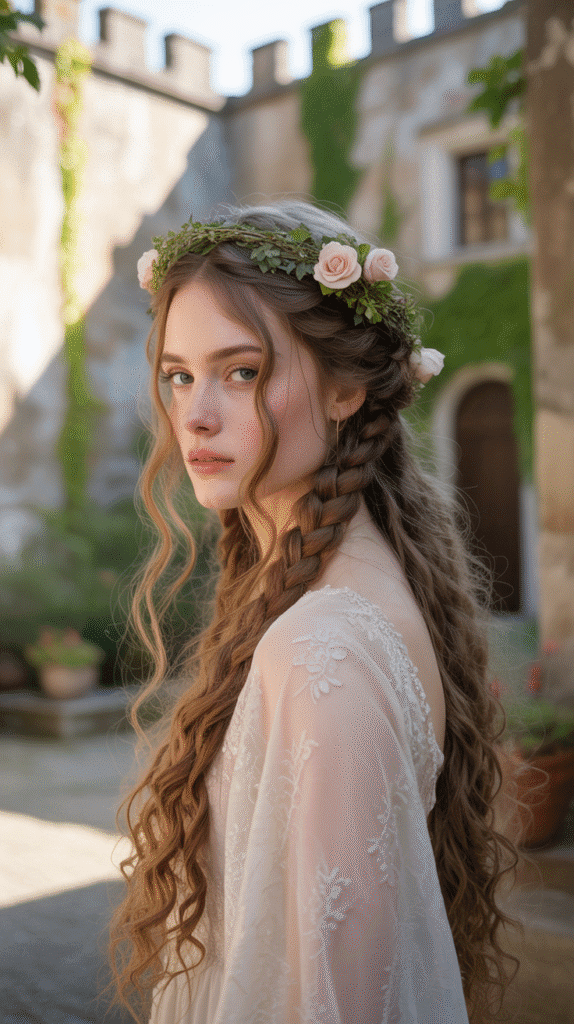
Combining practicality with elegance, the double braided half-up style was favored by medieval noblewomen who needed their hair both beautiful and functional.
This versatile look frames the face while showcasing length and texture.
Construction Details:
- Two sections of hair are taken from the temple areas, each approximately two inches wide.
- These sections are braided using French, Dutch, or traditional three-strand techniques depending on desired texture.
- The braids meet at the crown or slightly below, where they’re secured together with decorative pins or ribbon.
- Remaining hair flows freely or is curled for added volume and romance.
- Small flowers, ribbons, or jeweled clips can accentuate the braided sections for personalized detail.
4. The Waterfall Braid Crown
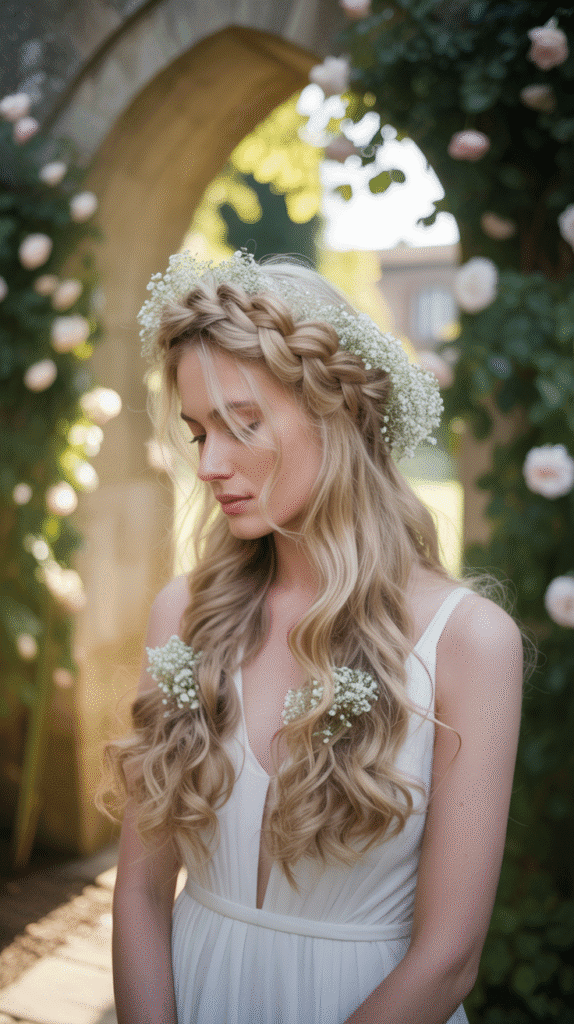
This intricate style creates a cascading effect that mimics flowing water, representing the medieval fascination with nature’s beauty.
The waterfall braid technique adds dimensional interest while maintaining a soft, romantic aesthetic.
Technical Approach:
- The waterfall braid begins at one temple and works around the head in a circular pattern.
- As the braid progresses, sections are dropped to create the “waterfall” effect while new sections are incorporated.
- This technique requires practice but creates stunning visual movement and texture.
- The dropped sections blend seamlessly with the remaining hair, which can be curled or left natural.
- Small floral accents or pearl pins enhance the ethereal quality of this sophisticated style.
5. Medieval Low Bun with Veil
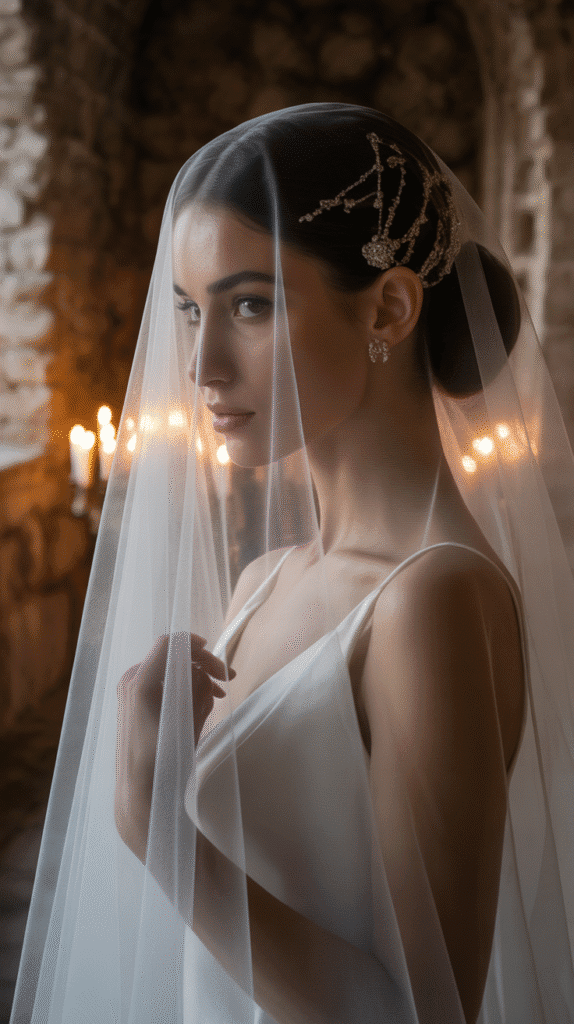
The low bun represented modesty and refinement in medieval culture, particularly among married noblewomen.
This elegant updo provides the perfect foundation for traditional veils and elaborate headpieces.
Assembly Process:
- Hair is gathered at the nape of the neck, creating a smooth or textured foundation depending on preference.
- The ponytail is twisted, braided, or rope-twisted before being wrapped into a circular bun shape.
- Pins secure the bun at multiple points to ensure stability throughout the wedding day.
- A medieval-style veil can be attached above, below, or integrated into the bun structure.
- Decorative elements like jeweled pins, small braids wrapped around the bun, or fresh flowers add personalized touches.
6. The Side Braid with Flowers
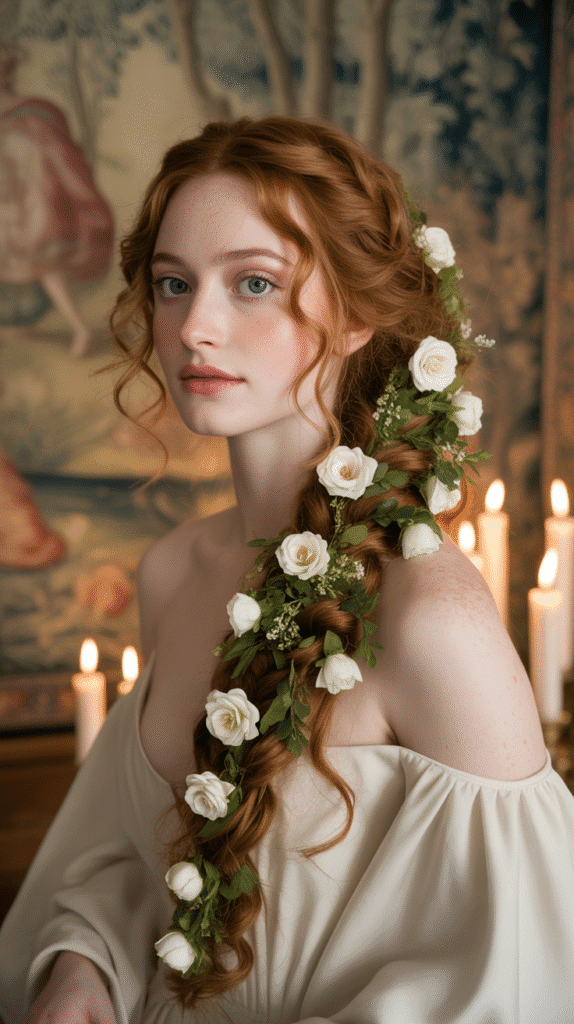
Asymmetrical styles gained popularity in later medieval periods, with side braids offering both practicality and romantic appeal.
This style draws attention to the bride’s profile while maintaining medieval authenticity.
Design Components:
- All hair is swept to one side, creating an asymmetrical foundation that’s both modern and historically inspired.
- A thick braid is created using three-strand, fishtail, or rope-braid techniques for varied texture.
- Fresh flowers are strategically placed throughout the braid, either woven during creation or pinned afterward.
- The opposite side can feature a small decorative braid or be left smooth for contrast.
- This style works beautifully with off-shoulder gowns or dresses with asymmetrical necklines.
7. The Twisted Updo with Jeweled Pins
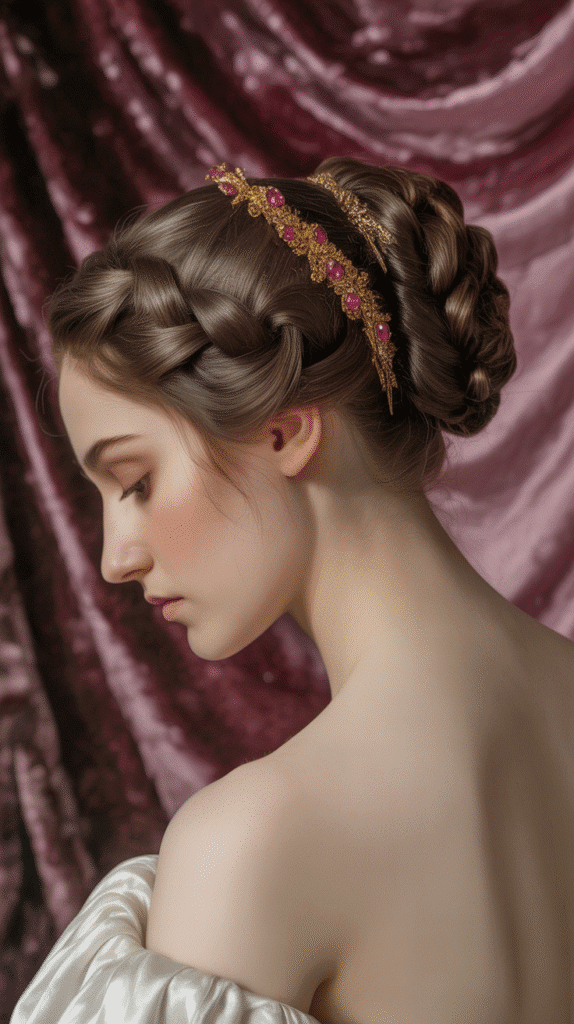
Medieval nobility often adorned their hair with precious metals and gemstones, displaying wealth and status through elaborate hairstyling.
The twisted updo recreates this regal aesthetic with modern techniques.
Construction Method:
- Hair is sectioned into multiple parts, typically four to six sections depending on thickness and length.
- Each section is twisted individually, creating rope-like strands with dimensional texture.
- The twisted sections are pinned strategically to create a sculptural updo with visible texture and movement.
- Jeweled pins are inserted at key points, both for security and decorative impact.
- This style offers excellent hold for all-day wear and complements formal medieval-inspired gowns beautifully.
8. Natural Curls with Floral Crown
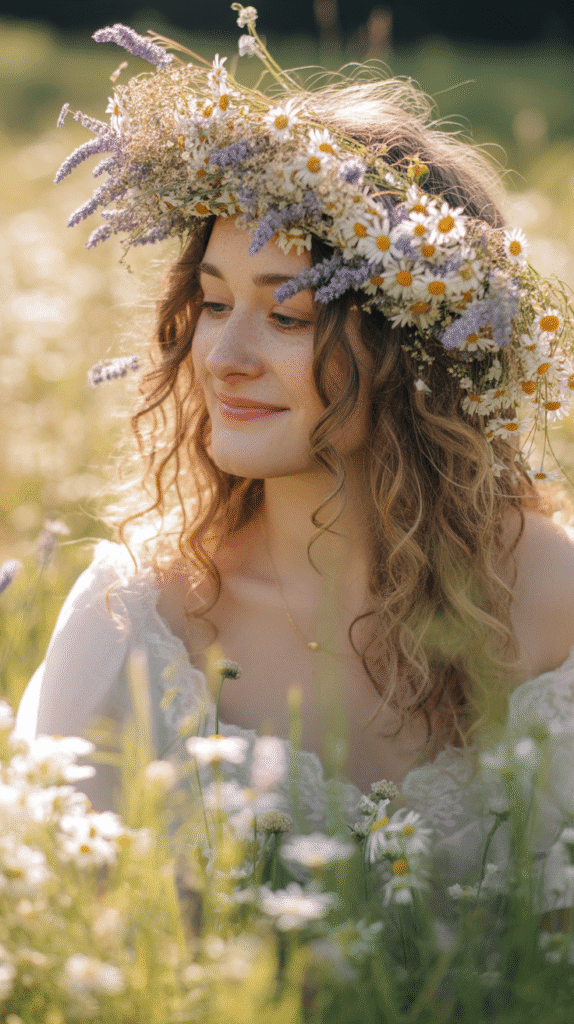
The simplicity of natural curls adorned with fresh flowers epitomizes the medieval appreciation for nature’s beauty.
This effortless style celebrates texture while incorporating botanical elements central to medieval symbolism.
Styling Essentials:
- Natural curl patterns are enhanced with curl-defining products rather than altered with heat tools.
- Hair is left loose and voluminous, creating a halo effect that frames the face.
- A substantial floral crown is constructed using wire base or flexible floral tape technique.
- Flowers should be chosen based on season, personal meaning, and color palette of the wedding.
- This style works particularly well for outdoor medieval-themed weddings and garden ceremonies.
9. The Rope Braid Updo
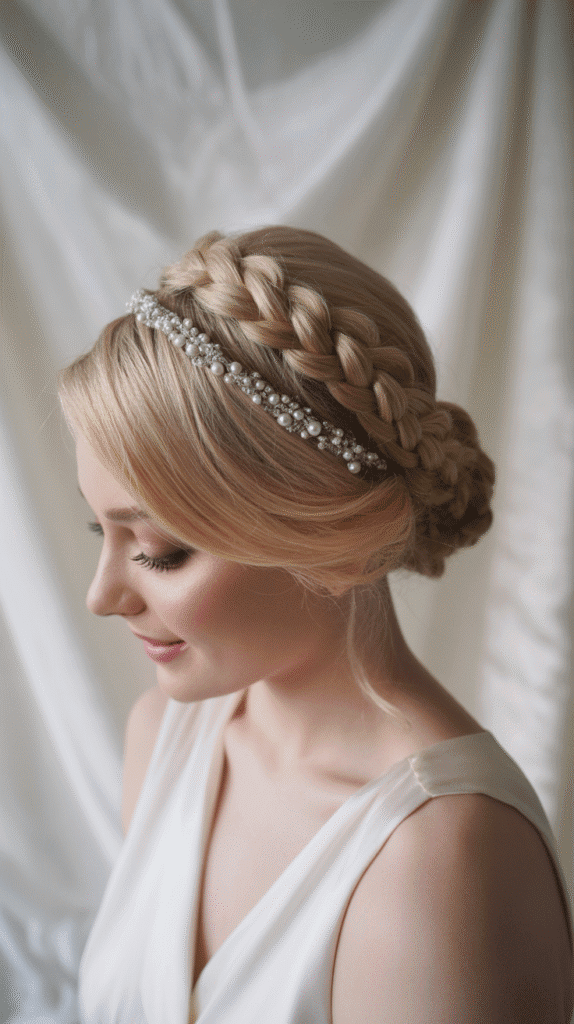
Rope braiding creates a twisted, textured effect that was both practical and decorative in medieval times.
This technique produces a sophisticated updo suitable for formal weddings.
Technical Execution:
- Hair is divided into two large sections which are each twisted in the same direction.
- The two twisted sections are then wrapped around each other in the opposite direction, creating the rope effect.
- This rope braid is coiled and pinned into an updo formation at the back or side of the head.
- The smoothness of the front sections contrasts beautifully with the textured rope braid.
- Pearl or crystal pins add sparkle and secure the style for lasting hold.
10. Half-Up with Cascading Curls
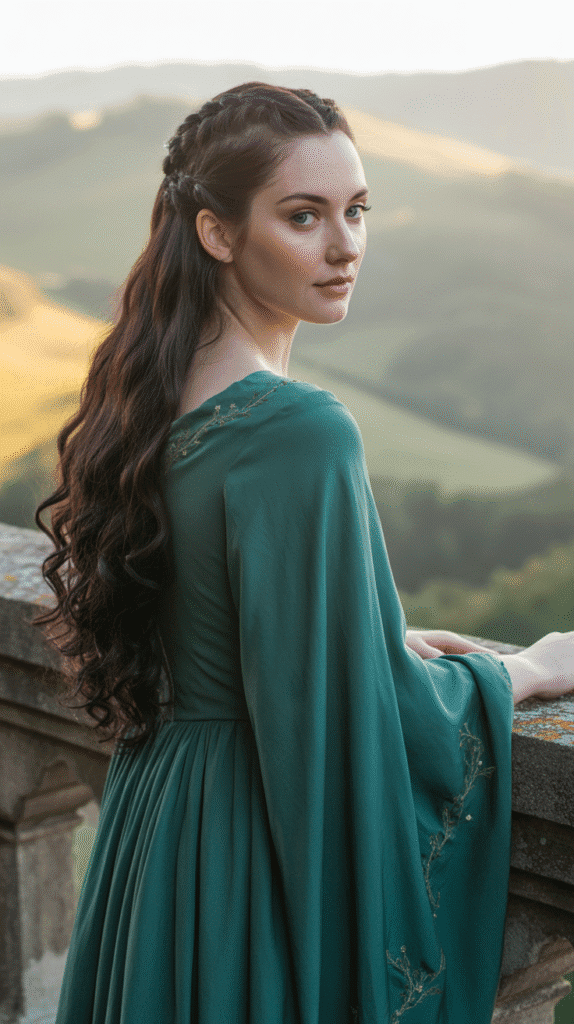
This style balances the formality of an updo with the romance of flowing hair, creating a versatile look suitable for various medieval wedding themes.
It offers the best of both worlds for brides who can’t decide between up or down.
Styling Components:
- The top section of hair, from temples to crown, is gathered and secured at the back of the head.
- This section can be twisted, braided, or simply smoothed depending on desired texture.
- The remaining hair falls freely in curls that have been set with heat tools or natural methods.
- Small decorative elements like braided accents or flower clusters enhance the transition point.
- This style accommodates veils, crowns, and other headpieces with ease.
11. The Milkmaid Braid
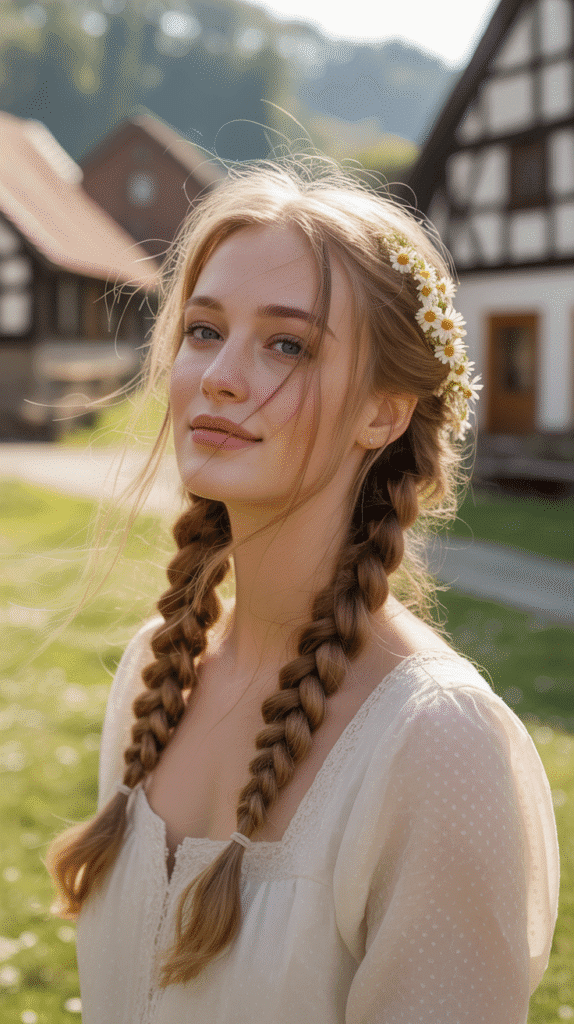
Named for its practical origins among working medieval women, the milkmaid braid has become a beloved bridal style for its charming simplicity and romantic appeal.
This style wraps braids across the crown like a natural headband.
Assembly Instructions:
- Hair is parted down the middle and divided into two equal sections.
- Each section is braided from the base, using regular or Dutch braid techniques.
- The braids are brought up and across the top of the head, creating a crown-like effect.
- They’re pinned securely where they meet and at intervals along their length for stability.
- Loose pieces are left or pulled out intentionally for a softer, more romantic finish.
12. Elegant Chignon with Veil Attachment
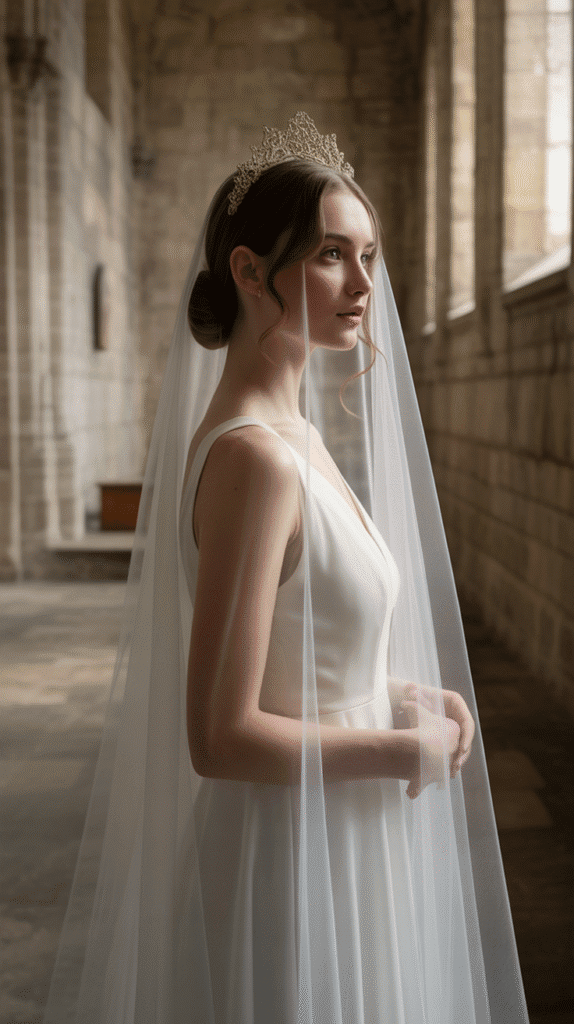
The chignon represents timeless elegance and was particularly favored among medieval aristocracy for formal occasions.
This sophisticated updo provides an ideal foundation for elaborate veils and headpieces.
Professional Technique:
- Hair is brushed smooth and gathered into a low ponytail at the nape of the neck.
- The ponytail is twisted or rolled under to create the classic chignon shape.
- Pins are inserted horizontally through the chignon to secure it firmly to the head.
- A medieval-style veil is attached using an ornate comb placed strategically above or integrated into the chignon.
- This polished style suits formal cathedral weddings and traditional medieval ceremonies.
13. The Twisted Crown with Loose Ends
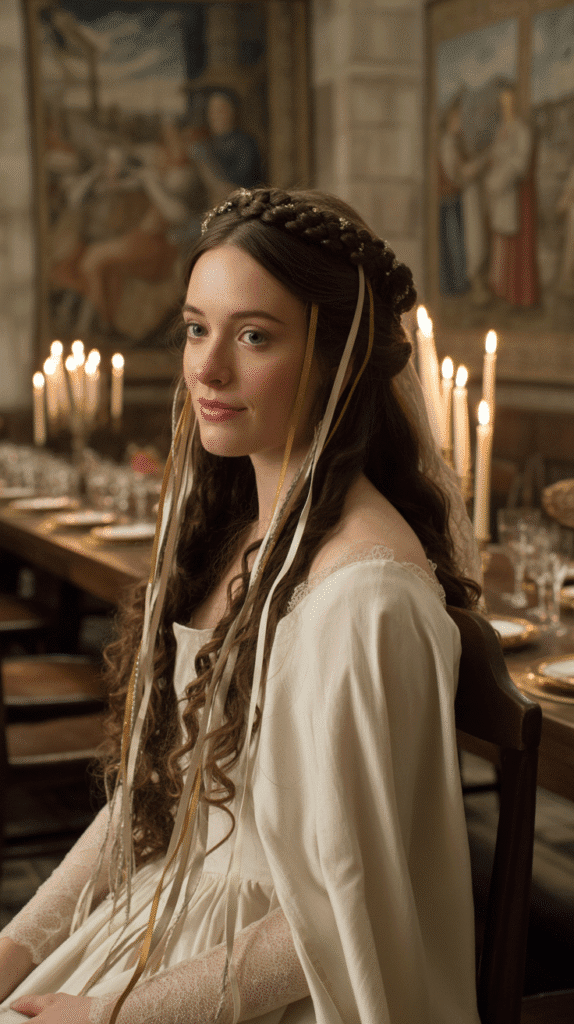
Creating a crown effect through twisting rather than braiding offers a softer, more flowing alternative while maintaining medieval elegance.
This style combines structure with movement.
Construction Details:
- Sections of hair from around the perimeter are twisted away from the face.
- These twisted sections are pinned to create a crown or halo effect around the head.
- The ends of the twisted sections are left loose and blend with the remaining untwisted hair.
- Ribbons, small flowers, or delicate chains can be woven through the twisted crown.
- This style offers versatility and works well with both casual and formal medieval wedding themes.
14. Medieval Side Updo with Accessories
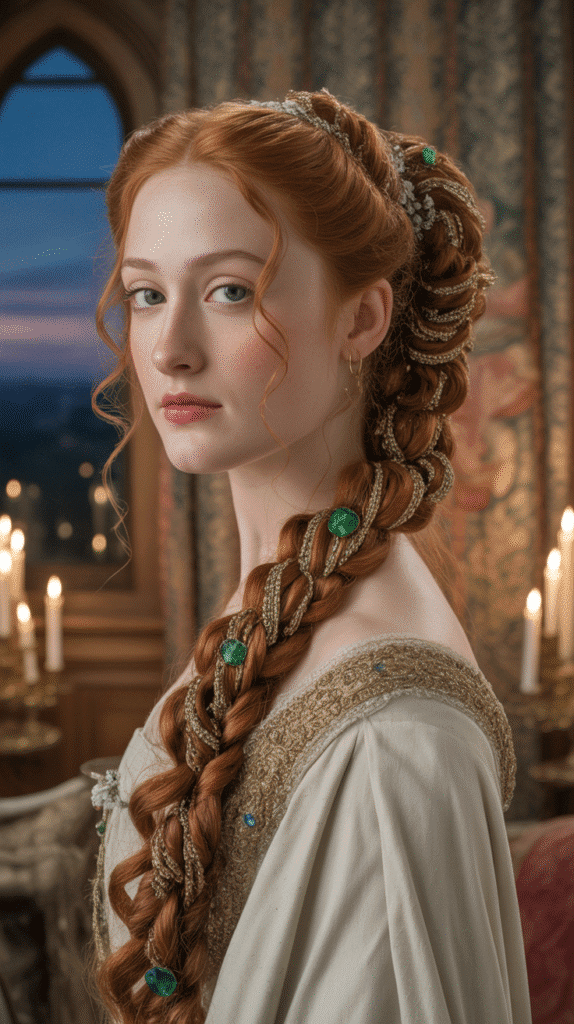
Asymmetrical updos became fashionable in later medieval periods, allowing ladies to display elaborate hairpieces and jeweled ornaments.
This dramatic style makes a bold statement while maintaining period authenticity.
Design Process:
- All hair is swept to one side, creating a dramatic asymmetrical foundation.
- Sections are twisted, braided, or curled and then pinned into a sculptural formation.
- The updo sits at shoulder level or slightly above, creating visual interest in profile.
- Medieval-inspired accessories like chains, jeweled pins, or metal ornaments are integrated throughout.
- This style pairs beautifully with gowns featuring one-shoulder or asymmetrical necklines.
15. The Boho Medieval Braid
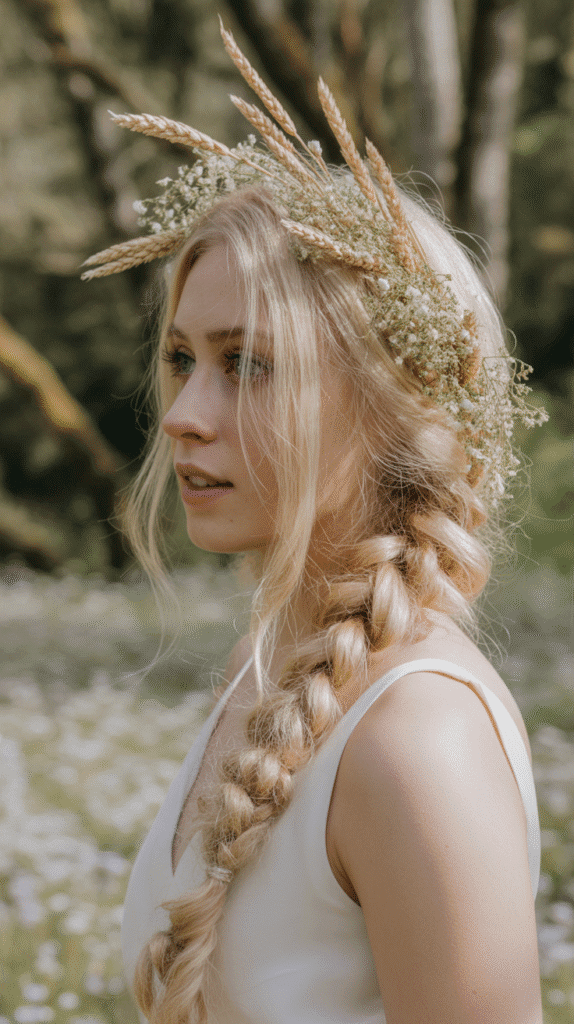
Combining bohemian looseness with medieval braiding techniques creates a relaxed yet romantic style perfect for outdoor or rustic medieval weddings.
This approach celebrates texture and natural beauty.
Styling Approach:
- Hair is braided loosely, allowing texture and volume rather than tight precision.
- Sections are deliberately pulled and loosened to create a fuller, more relaxed appearance.
- Wildflowers, herbs, and natural elements are incorporated throughout the braid.
- Face-framing pieces are left out intentionally for a soft, romantic effect.
- This style works exceptionally well for garden, woodland, or countryside medieval-themed weddings.
16. High Braided Bun
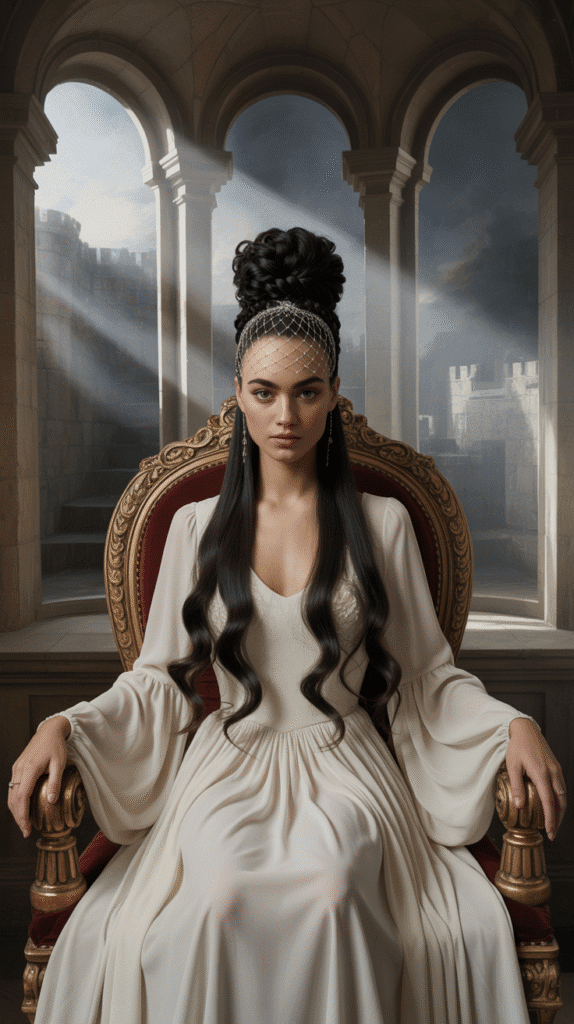
Medieval noblewomen sometimes wore their hair in elevated styles to accommodate elaborate headdresses and crowns.
The high braided bun offers regal height while maintaining intricate textural detail.
Technical Assembly:
- Hair is gathered into a high ponytail at the crown of the head, creating immediate elevation.
- The ponytail is braided using preferred technique, then wrapped into a bun formation.
- Additional small braids can be created and wrapped around the base for added detail.
- A jeweled hairnet or decorative pins secure the style and add medieval authenticity.
- This elevated style suits formal weddings and complements ball gown-style medieval dresses.
17. The Celtic Knot Braid
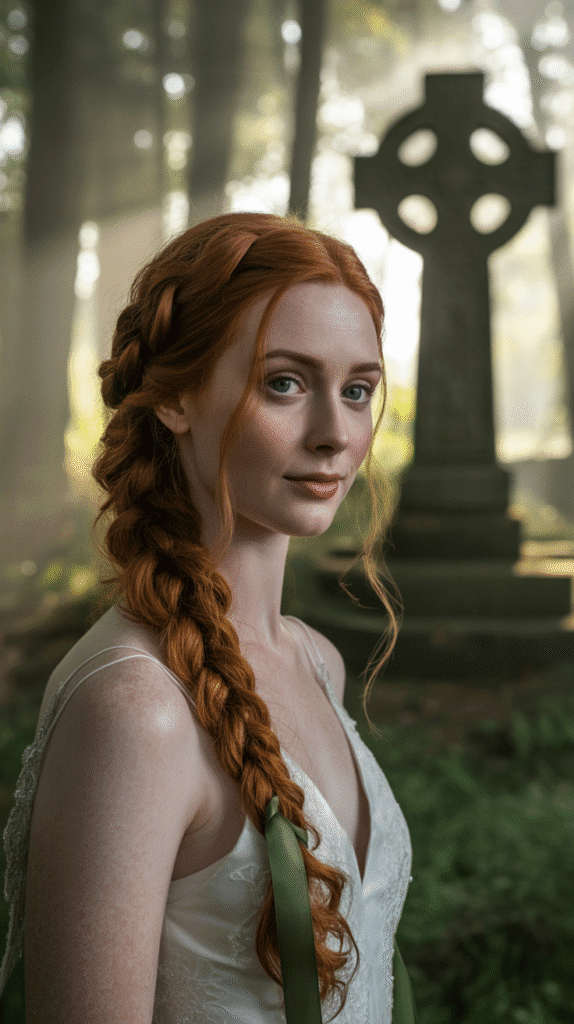
Drawing inspiration from Celtic medieval traditions, this intricate style features interwoven sections that create complex knot patterns.
It represents the interconnection of life and love in Celtic symbolism.
Advanced Technique:
- Multiple small sections are braided separately, typically four to six strands.
- These braids are woven together following Celtic knot patterns, creating geometric designs.
- The technique requires planning and precision to achieve authentic knot appearances.
- Green, gold, or blue ribbons can be incorporated to enhance the Celtic aesthetic.
- This specialized style celebrates Irish and Scottish medieval heritage beautifully.
18. Loose Low Ponytail with Ribbon
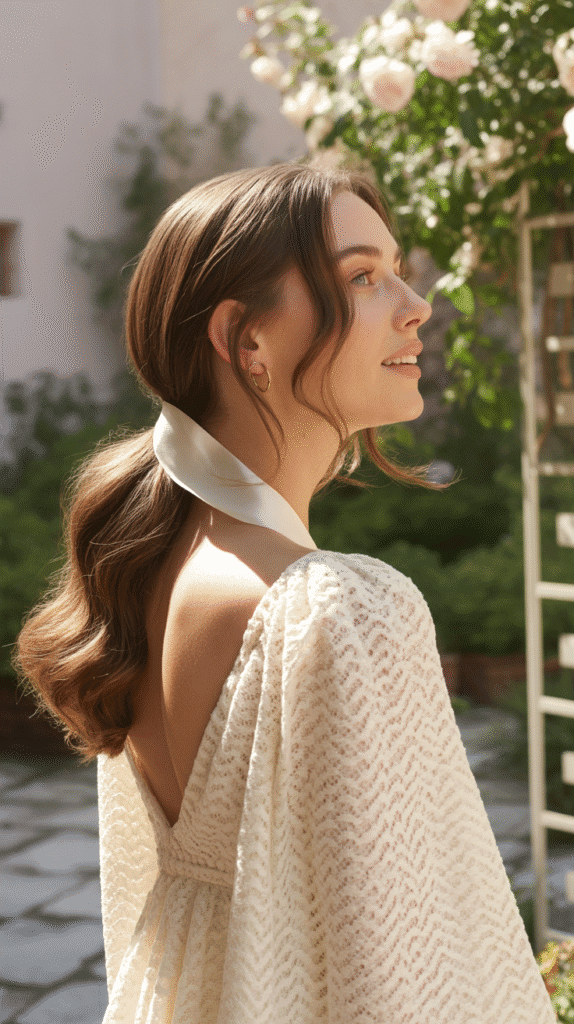
The simplicity of a loosely gathered ponytail adorned with ribbon captures the essence of medieval practicality elevated to bridal elegance.
This understated style lets natural beauty shine.
Styling Elements:
- Hair is gathered loosely at the nape without pulling too tightly, maintaining soft volume.
- A luxurious silk or velvet ribbon is wrapped around the base and tied in a bow.
- The ponytail itself can be left straight, wavy, or gently curled depending on hair texture.
- Face-framing pieces are left out or pulled loose for a softer, more romantic effect.
- This minimalist approach suits intimate medieval weddings and rustic celebrations.
19. The Crown Braid with Center Part
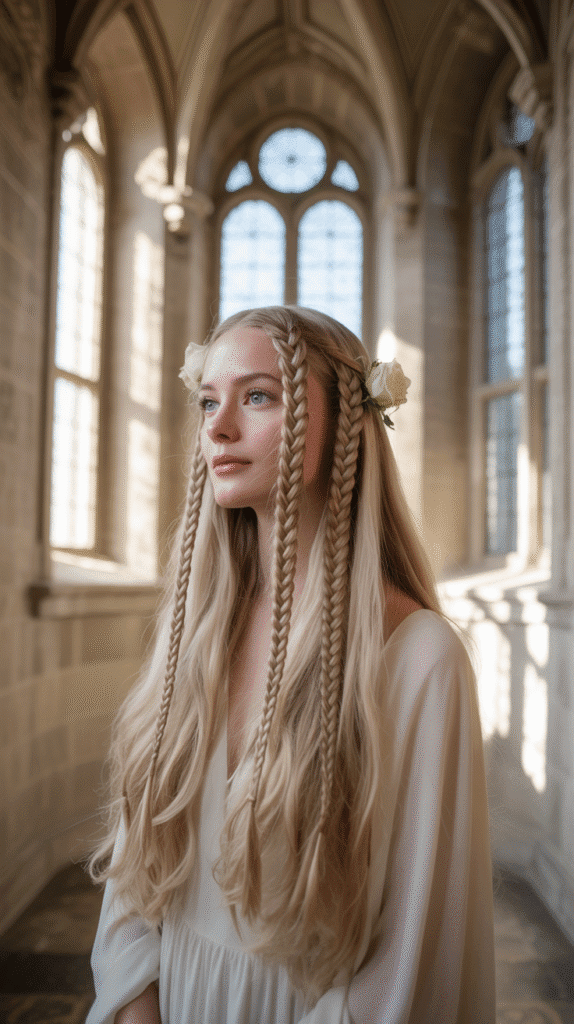
A center part adds symmetry and classical balance to the crown braid, creating a look that’s both structured and romantic.
This style frames the face beautifully while maintaining historical accuracy.
Construction Method:
- Hair is precisely parted down the center from forehead to nape.
- Dutch or French braids begin at the part and work backward along each side of the head.
- The braids continue around the head until they meet at the back or side.
- Ends are tucked and pinned seamlessly to maintain the crown illusion.
- This symmetrical style suits brides seeking classical balance and formal elegance.
20. Textured Low Updo with Accessories
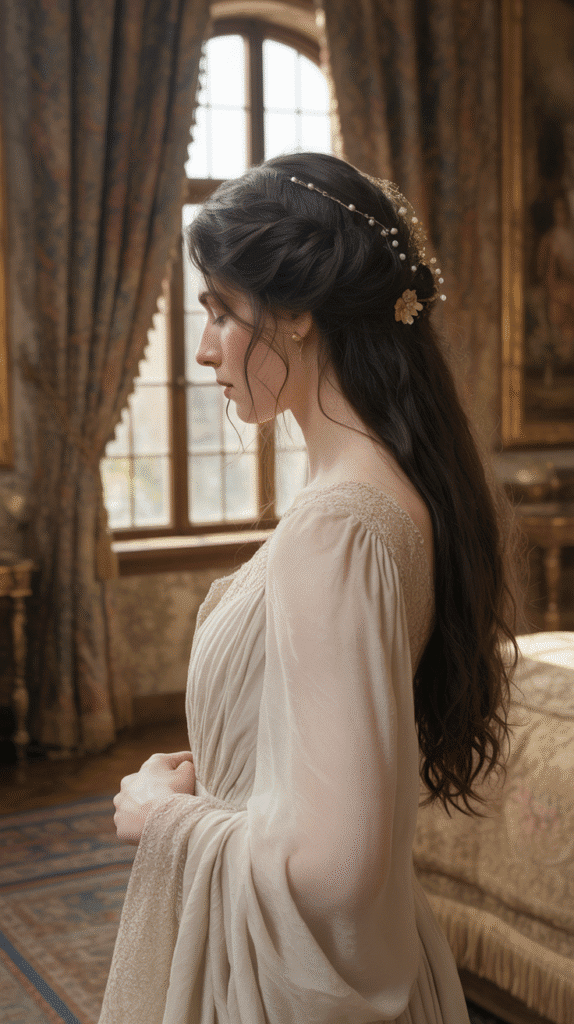
Creating texture through teasing, twisting, and strategic pinning produces a dimensional updo that captures medieval opulence.
This style serves as a canvas for displaying precious accessories.
Professional Approach:
- Hair is sectioned and each section is teased or backcombed to create foundational volume.
- Sections are twisted, rolled, or pinned to create a sculptural, textured updo.
- The finished updo should have visible dimension rather than smooth uniformity.
- Accessories like pearl pins, jeweled combs, or small metalwork are integrated throughout.
- This elaborate style suits formal medieval weddings and evening ceremonies.
21. The Half-Crown Braid
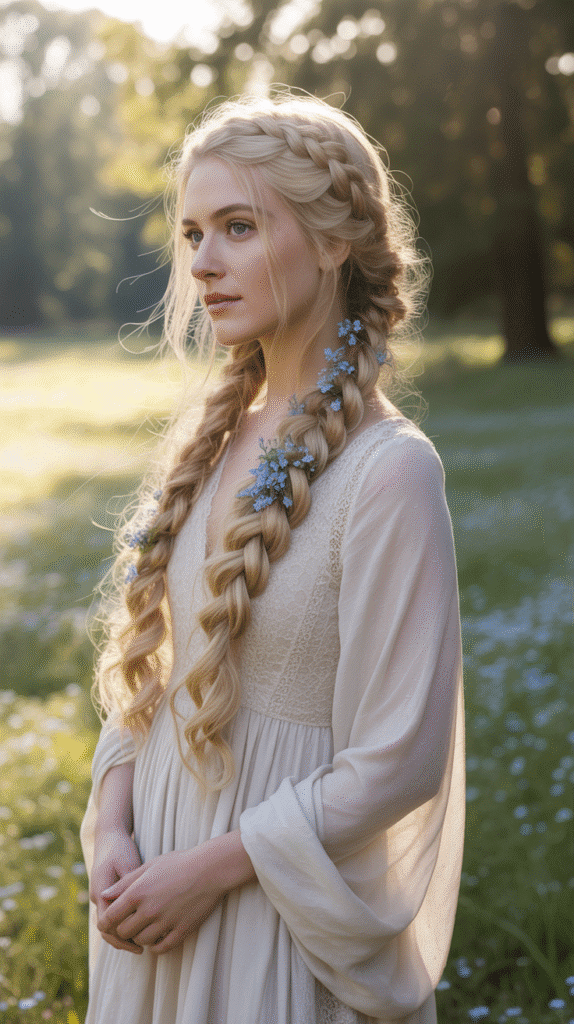
Offering a more subtle alternative to full crown braids, the half-crown wraps from ear to ear across the back of the head.
This style provides structure while allowing most hair to flow freely.
Styling Details:
- A section of hair is taken from one ear across the back of the head to the opposite ear.
- This section is braided using preferred technique, creating a horizontal band of texture.
- The remaining hair above and below the braid flows freely or is styled separately.
- Small flowers or decorative pins can be placed along the braid’s length.
- This versatile style works well with veils and allows easy integration of headpieces.
22. Victorian-Medieval Fusion Updo
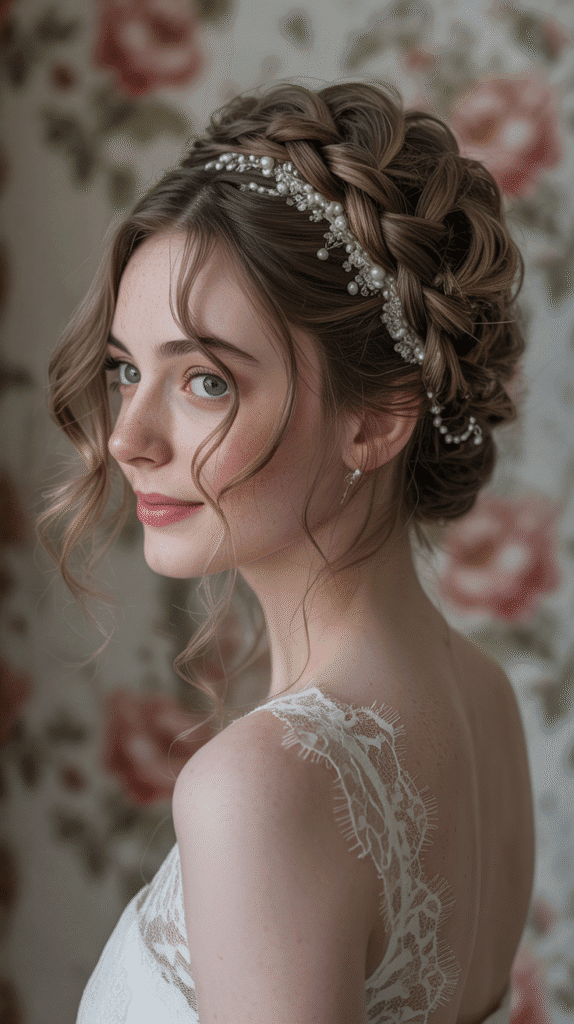
While Victorian style came centuries after medieval times, combining elements creates a romantic fusion perfect for fairytale weddings.
This style blends medieval braiding with Victorian elegance.
Design Components:
- Multiple sections are braided separately using various techniques for visual diversity.
- These braids are coiled, twisted, and pinned together into an elaborate updo.
- Loose tendrils are curled and left to frame the face in Victorian fashion.
- Lace elements, pearl pins, or cameo brooches add to the fusion aesthetic.
- This romantic style suits brides drawn to both periods’ romantic elements.
23. The Wrapped Braid Bun
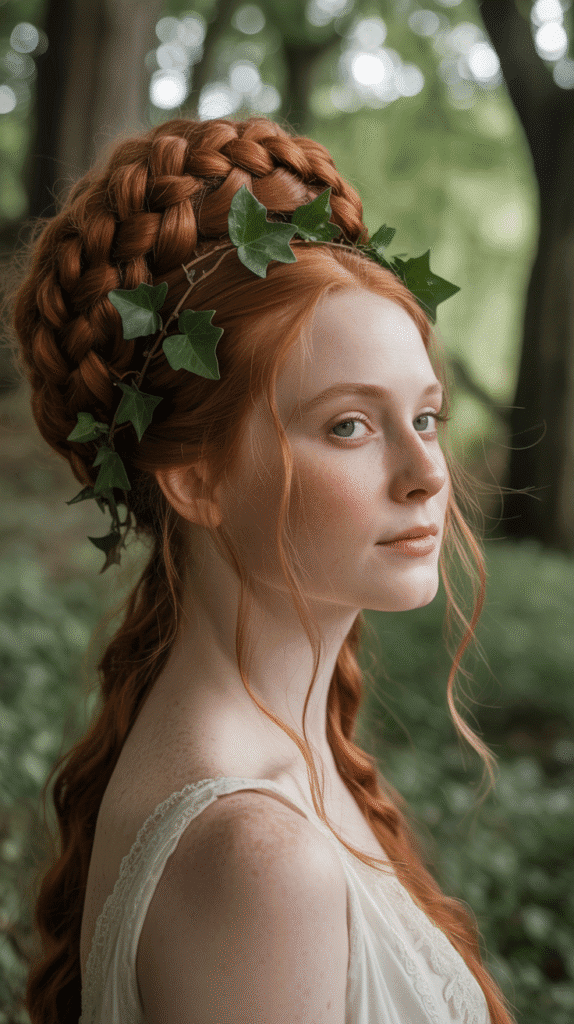
Wrapping a thick braid around itself creates a substantial bun with visible textural detail.
This style combines the practicality of an updo with the decorative appeal of visible braiding.
Assembly Process:
- Hair is gathered and braided in a single thick braid using three or more strands.
- The braid is wrapped in a spiral pattern, either from the center outward or base to tip.
- Pins secure the wrapped braid at multiple points for stability.
- The visible braid texture creates dimensional interest in the finished bun.
- Natural elements like leaves, small flowers, or ribbons can be tucked between wrapped sections.
24. Loose Waves with Pearl Headband
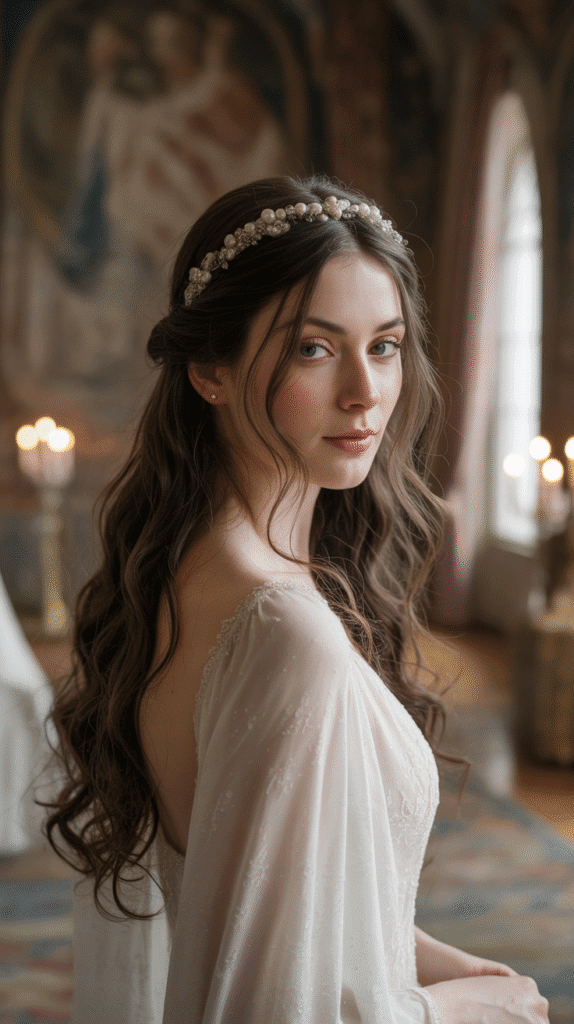
Medieval nobility often wore jeweled headbands that sat across the forehead, denoting rank and wealth.
Pairing this accessory with loose waves creates effortless elegance.
Styling Essentials:
- Hair is styled in loose, natural-looking waves using large-barrel tools or no-heat methods.
- A pearl headband, whether single or multi-strand, is positioned approximately one inch from the hairline.
- The headband should sit securely but not too tightly, avoiding headache during long celebrations.
- Waves can be left completely down or partially pulled back for variation.
- This simple yet elegant style suits both formal and casual medieval wedding themes.
25. The Romantic Side Twist
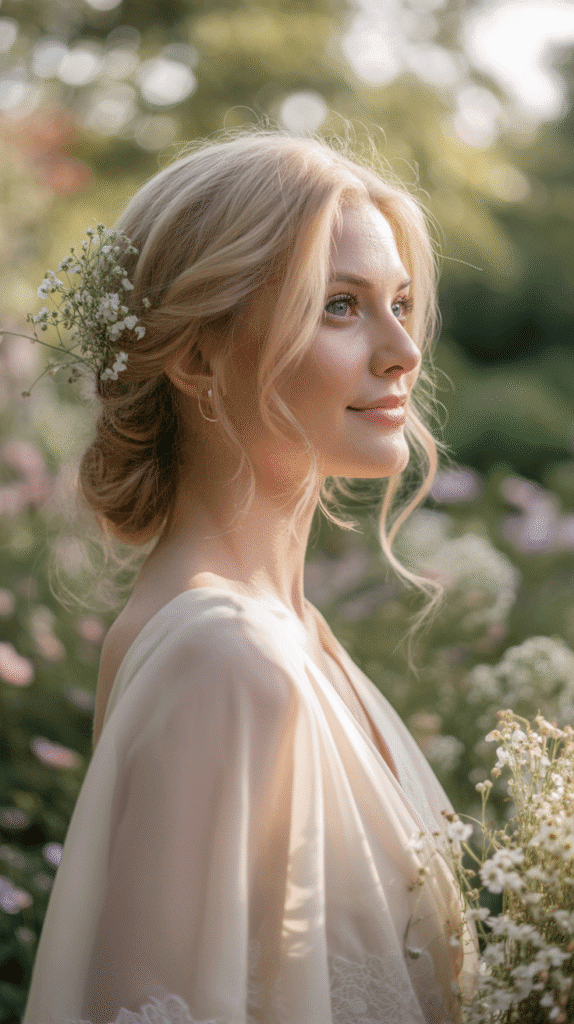
Gathering hair into a soft side twist creates an asymmetrical style that’s both romantic and practical.
This flowing style maintains movement while keeping hair elegantly controlled.
Construction Technique:
- All hair is swept to one side, creating the foundation for asymmetrical styling.
- Sections are loosely twisted rather than tightly, maintaining soft, romantic texture.
- The twist is secured with pins concealed by flowers or decorative elements.
- Remaining ends fall freely in curls or waves over the shoulder.
- This versatile style accommodates various accessories and works well with one-shoulder gowns.
26. Medieval Headband Braid
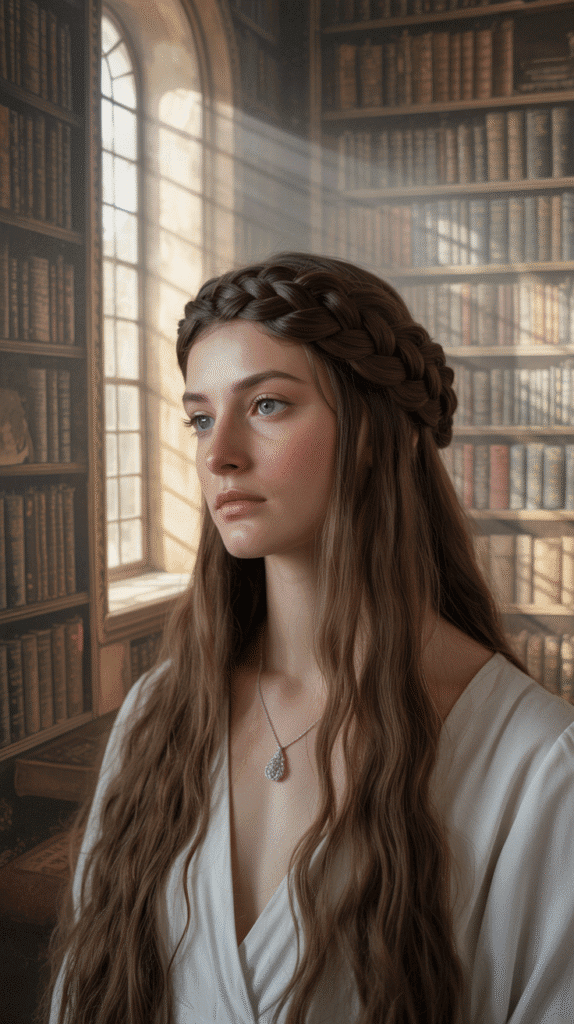
Creating a braid that serves as a natural headband offers both decorative appeal and practical function.
This style keeps hair away from the face while maintaining medieval authenticity.
Styling Method:
- A section of hair is taken from ear to ear across the top/front of the head.
- This section is braided to create a headband effect that sits approximately two inches from the hairline.
- The remaining hair can be left straight, curled, or styled separately.
- The headband braid keeps hair away from the face during ceremony and celebration.
- Small decorative pins or flowers can accent the braid without overwhelming the simplicity.
27. The Twisted Low Chignon
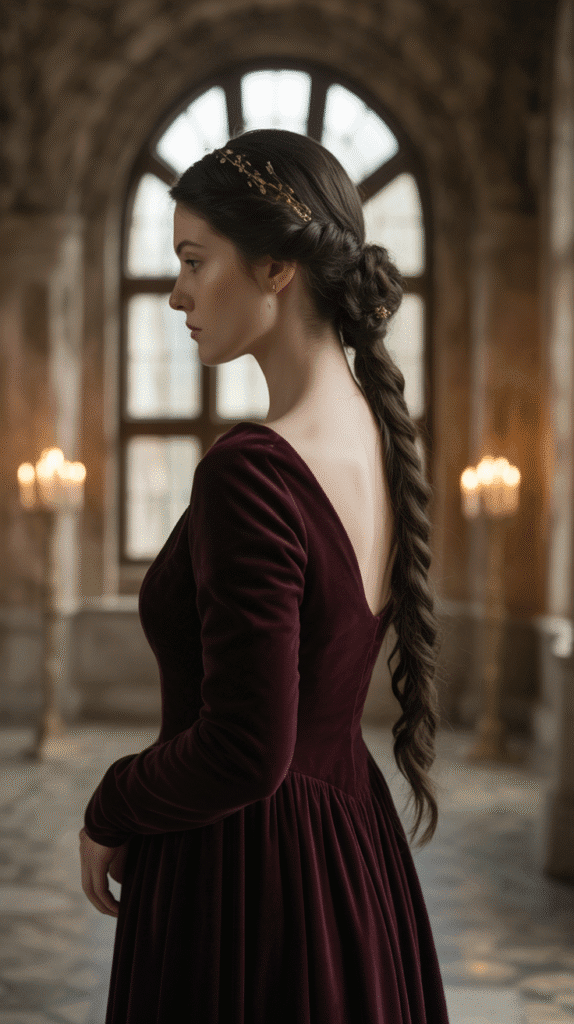
Twisting sections before forming a chignon creates additional texture and visual interest while maintaining the elegance of a classic updo.
This refined style suits formal medieval ceremonies.
Professional Execution:
- Hair is divided into multiple sections, typically four to six depending on thickness.
- Each section is twisted individually before being gathered at the nape of the neck.
- The twisted sections are pinned together into a chignon formation with visible texture.
- Gold or jeweled pins are inserted at key points for both security and decoration.
- This sophisticated style pairs beautifully with formal medieval gowns and cathedral veils.
28. Voluminous Curls with Jeweled Circlet
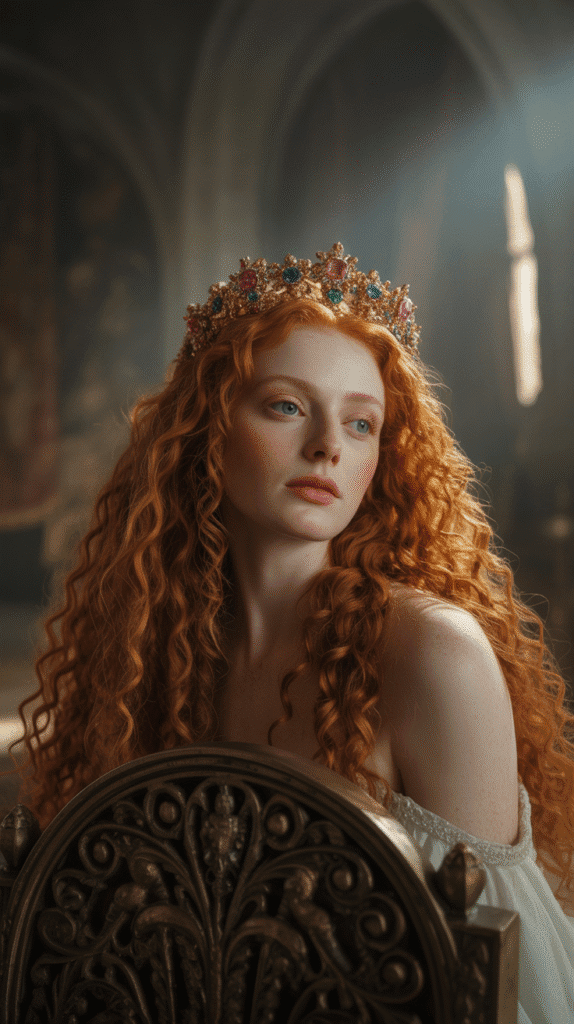
Creating maximum volume with curls and topping with an ornate circlet embodies medieval opulence.
This dramatic style makes a statement worthy of royalty.
Styling Approach:
- Hair is curled using various sized barrels to create diverse curl patterns for natural-looking volume.
- Curls are brushed out or separated to create maximum fullness and body.
- Volumizing products and teasing at the crown enhance the dramatic effect.
- An elaborate jeweled circlet is positioned prominently on the head, secured with pins.
- This bold style suits confident brides seeking maximum medieval glamour and drama.
29. The Braided Updo with Fresh Flowers
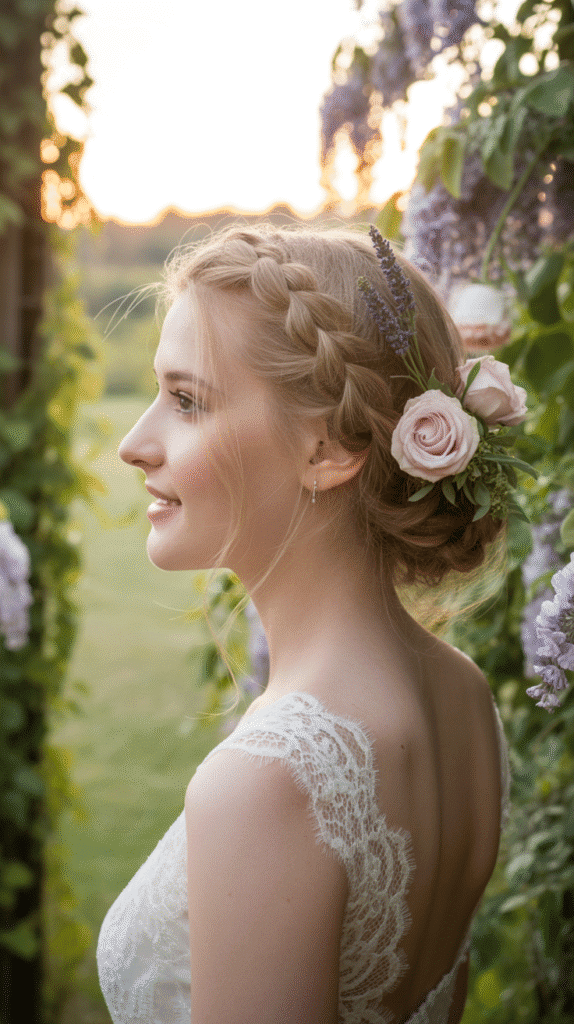
Incorporating fresh flowers directly into a braided updo creates a living work of art that celebrates nature’s beauty alongside skilled hairstyling.
This style connects the bride to medieval botanical traditions.
Design Integration:
- Multiple braids are created and woven together into an updo formation.
- Fresh flower stems are inserted during the braiding process or pinned afterward.
- Flowers should be chosen for both aesthetic appeal and structural integrity for all-day wear.
- A mix of blooms and greenery creates depth and natural beauty.
- Flowers can be applied strategically or abundantly depending on desired effect.
30. Simple Center Part with Face-Framing Braids
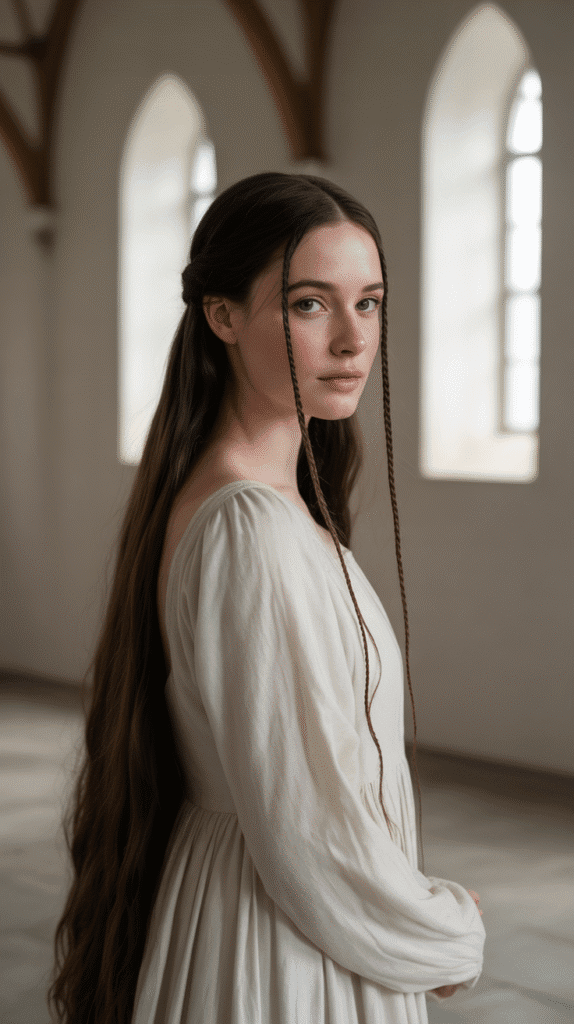
Minimalist medieval styling often featured simple center parts with decorative elements near the face.
Small braids on either side frame features beautifully while maintaining simplicity.
Styling Simplicity:
- Hair is parted precisely down the center from forehead to nape.
- Small, thin braids are created on each side, beginning near the temples.
- These face-framing braids can be left loose or pinned back with the remaining hair.
- The rest of the hair remains straight or slightly waved, emphasizing natural texture.
- This understated style suits intimate weddings and brides preferring minimal intervention.
31. The Ladder Braid Half-Up
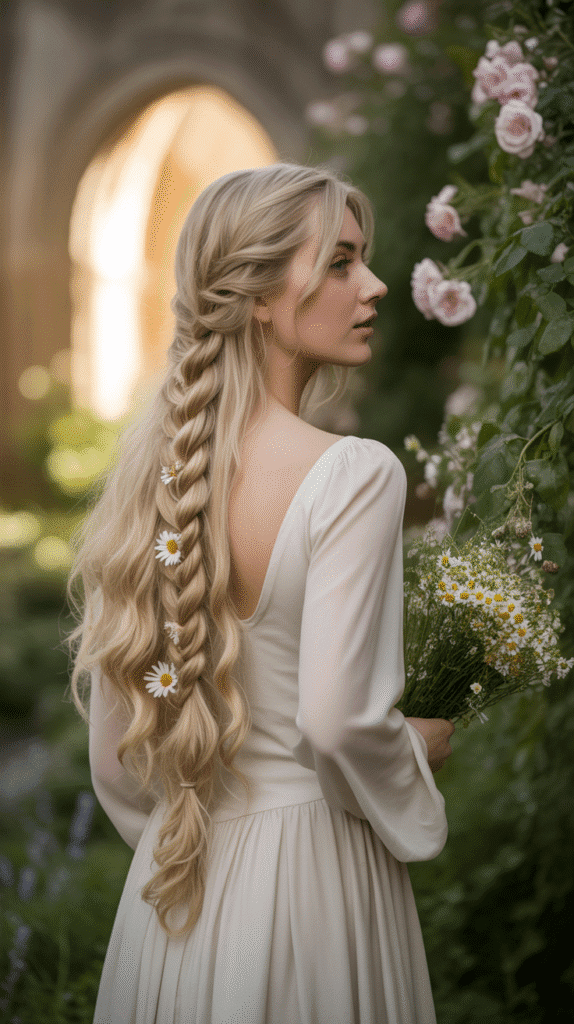
The ladder braid creates a unique woven appearance that resembles a decorative ladder climbing up the hair.
This intricate technique adds medieval artistry to a practical half-up style.
Advanced Technique:
- This specialized braid requires creating a central braid with horizontal sections woven through it.
- The ladder braid typically begins at the crown and extends several inches down.
- The remaining hair flows freely beneath the ladder pattern.
- Small flowers or ribbons can be woven through the “rungs” of the ladder.
- This statement style suits brides seeking unique medieval hairstyling artistry.
32. Elegant Twisted Ponytail
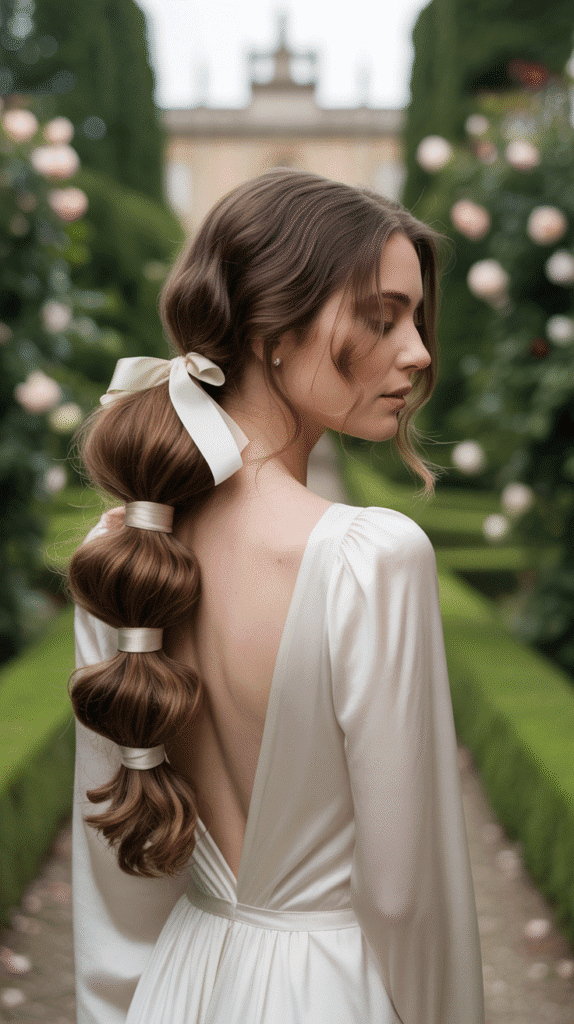
Elevating a simple ponytail with twisted sections transforms this practical style into bridal-worthy elegance.
The combination of simplicity and sophistication captures medieval sensibility.
Styling Technique:
- Hair is gathered into a low or mid-level ponytail at the back of the head.
- Small sections from the ponytail are twisted and wrapped around the base.
- These twisted sections conceal the hair elastic and add dimensional detail.
- The ponytail itself can be curled, waved, or braided for additional interest.
- A ribbon or jeweled hairpiece at the base adds a finishing medieval touch.
33. The Romantic Undone Updo
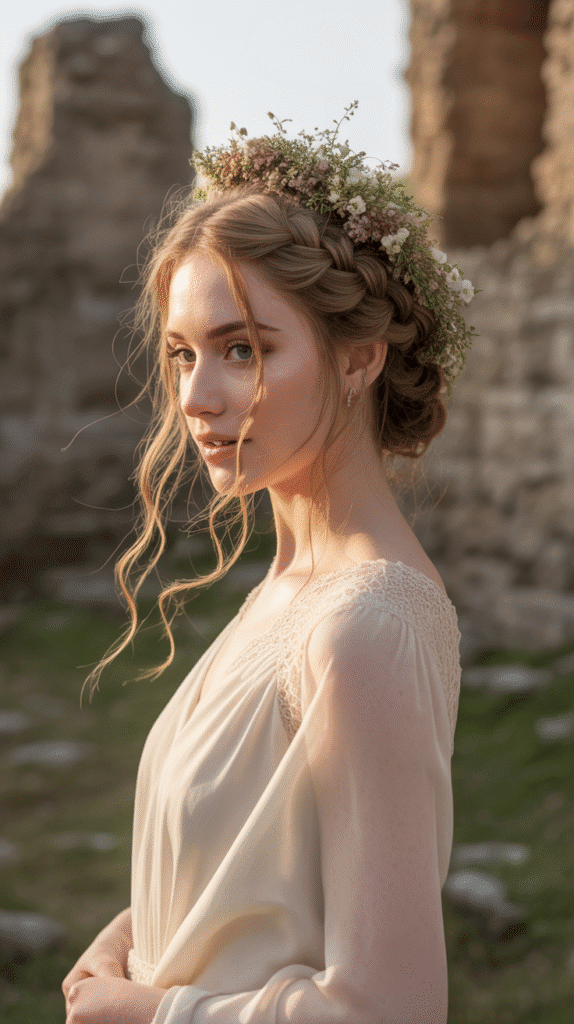
The undone updo celebrates imperfection and natural beauty, with intentionally loose pieces and textured sections creating an effortlessly romantic medieval aesthetic.
This modern take on medieval styling feels both timeless and contemporary.
Styling Philosophy:
- Hair is gathered loosely rather than tightly, allowing natural texture and movement.
- Sections are twisted, braided, or simply pinned without excessive smoothing or control.
- Pieces are intentionally pulled out and left loose to frame the face and create softness.
- The overall effect should appear naturally beautiful rather than overly styled.
- This relaxed approach suits bohemian medieval weddings and outdoor celebrations.
Tips for Maintaining Medieval Hairstyles Throughout Your Wedding Day
Medieval-inspired hairstyles require special attention to ensure they remain beautiful from ceremony through reception.
Understanding proper maintenance techniques helps preserve your fairytale look.
Preparation Essentials:
- Schedule a trial session at least one month before the wedding to test style longevity.
- Use strong-hold hairspray designed for all-day wear, applying in light layers rather than one heavy coat.
- Bobby pins should match hair color exactly and be inserted correctly (wavy side down) for maximum grip.
- Hair should be clean but not freshly washed; one-day-old hair holds styles better than just-washed hair.
- Bring an emergency kit including extra pins, hairspray, and small flowers for quick touch-ups.
During the Event:
- Avoid excessive touching or adjusting of the hairstyle, as this loosens carefully placed pins.
- If wearing a veil, have someone assist with removal to prevent disrupting the underlying hairstyle.
- Schedule a quick touch-up before photographs or important moments like first dance.
- Consider the weather and venue conditions when selecting your hairstyle complexity.
- Communicate with your hairstylist about which styles best suit your hair type and texture.
Choosing Accessories for Your Medieval Wedding Hairstyle
The right accessories transform a beautiful hairstyle into an authentic medieval masterpiece.
Understanding historical accuracy while incorporating personal style creates the perfect balance.
Traditional Medieval Accessories:
- Circlets made of metal (gold, silver, bronze) sit across the forehead and symbolize nobility.
- Wimples and veils of various lengths represented modesty and marital status in medieval culture.
- Jeweled pins and combs displayed wealth and were often family heirlooms passed through generations.
- Fresh flowers held symbolic meanings, with roses representing love and daisies symbolizing innocence.
- Ribbons and silk cords in rich colors like deep red, royal blue, or emerald green added color and secured styles.
Modern Interpretations:
- Choose accessories that complement rather than overwhelm your natural beauty and hairstyle.
- Consider your dress neckline and details when selecting hair accessories for cohesive styling.
- Mix historical elements with personal touches like family jewelry or meaningful charms.
- Ensure all accessories are securely attached and won’t cause discomfort during extended wear.
- Work with your hairstylist to integrate accessories seamlessly into the overall design.
Hair Care Leading Up to Your Medieval Wedding
Preparing your hair in the weeks and months before your wedding ensures it’s in optimal condition for styling.
Healthy hair holds medieval styles better and photographs more beautifully.
Timeline for Hair Preparation:
- Two months before: Schedule any desired hair coloring or highlights, allowing time for adjustments if needed.
- Six weeks before: Get a trim to remove split ends while maintaining desired length for your chosen style.
- One month before: Have your hair trial to test the style and identify any needed adjustments.
- Two weeks before: Complete final color touch-ups if necessary, avoiding dramatic changes too close to the wedding.
- One week before: Do a final deep conditioning treatment but avoid trying new products that might cause reactions.
- Day before: Wash hair in the evening, allowing natural oils to return for better styling hold.
Daily Care Practices:
- Use sulfate-free shampoos that won’t strip natural oils essential for healthy hair.
- Apply leave-in conditioners to keep hair moisturized without weighing it down.
- Minimize heat styling in the months leading up to your wedding to prevent damage.
- Protect hair while sleeping using silk pillowcases or loose braids to prevent breakage.
- Stay hydrated and maintain a balanced diet rich in proteins and vitamins for hair health.
- Take biotin supplements if recommended by your healthcare provider to strengthen hair.
- Avoid chemical treatments like perms or relaxers within three months of your wedding.
Working with Your Hairstylist: Communication Tips
Clear communication with your hairstylist ensures your medieval wedding vision becomes reality.
Providing proper references and expressing your preferences leads to better results.
Before the Consultation:
- Gather inspiration photos showing multiple angles of hairstyles you admire from various sources.
- Consider your dress style, neckline, and overall wedding theme when selecting potential hairstyles.
- Know your hair’s limitations, including length, thickness, texture, and any styling challenges.
- Decide whether you want to incorporate extensions for added length or volume.
- Determine your budget for both the trial session and wedding day styling services.
During the Consultation:
- Show your hairstylist photos of your wedding dress, venue, and overall aesthetic vision.
- Discuss how long your hairstyle needs to last and what activities you’ll be doing.
- Ask about the hairstylist’s experience with medieval or historical styling techniques.
- Inquire about timeline requirements for wedding day styling and whether they travel to venues.
- Request product recommendations for maintaining the style throughout your celebration.
- Discuss backup plans in case of weather issues for outdoor weddings.
- Ask about the hairstylist’s policies regarding touch-ups during the reception.
Communication Best Practices:
- Be honest about what you like and dislike during the trial session.
- Speak up immediately if something feels uncomfortable or doesn’t match your vision.
- Take photos from multiple angles during the trial to review later in different lighting.
- Provide feedback about hold, comfort, and overall satisfaction with the trial style.
- Confirm all details in writing, including timing, location, and final costs.
Medieval Hairstyles for Different Hair Types and Textures
Not all medieval hairstyles work equally well for every hair type.
Understanding how to adapt these styles to your specific hair texture ensures beautiful, long-lasting results.
For Fine or Thin Hair:
- Add volumizing mousse at the roots before styling to create the appearance of thickness.
- Consider clip-in extensions to add fullness, particularly for styles requiring substantial braids.
- Tease sections lightly at the crown to create the illusion of more volume.
- Opt for styles that incorporate twists rather than tight braids, as twists appear fuller.
- Use texturizing spray to create grip and prevent styles from slipping throughout the day.
- Avoid heavy oils or serums that can weigh down fine hair and make it appear flat.
- Choose styles with multiple smaller braids rather than single thick braids for better proportions.
For Thick or Coarse Hair:
- Use smoothing serums or oils to tame frizz and create a more polished appearance.
- Allow extra time for styling, as thick hair requires more pins and patience to secure properly.
- Consider styles that embrace volume, such as textured updos or voluminous curls.
- Strong-hold products are essential to maintain style integrity throughout long wedding celebrations.
- Divide hair into multiple sections when creating braids to ensure manageability.
- Heavy accessories like substantial circlets or jeweled combs work particularly well with thick hair.
- Embrace your hair’s natural body rather than fighting against its texture.
For Curly or Textured Hair:
- Work with your natural curl pattern rather than straightening for more authentic, lasting styles.
- Use curl-defining products to enhance natural texture and reduce frizz throughout the day.
- Consider protective styles that maintain hair health while achieving medieval aesthetics.
- Braided styles work exceptionally well with textured hair and hold securely without excessive products.
- Stretch curls gently if needed for specific styles, but avoid harsh heat that damages texture.
- Floral crowns and loose styles beautifully complement natural curls and coils.
- Consult a hairstylist experienced with your specific hair texture for best results.
Seasonal Considerations for Medieval Wedding Hairstyles
Different seasons present unique challenges and opportunities for medieval hairstyling.
Adapting your chosen style to weather conditions ensures comfort and longevity.
Spring Wedding Considerations:
- Incorporate seasonal flowers like tulips, cherry blossoms, or peonies into floral crowns and accents.
- Be prepared for potential rain with styles that can withstand light moisture without falling apart.
- Use anti-humidity products if spring weather tends to be damp in your location.
- Lighter accessories work well with the fresh, renewal aesthetic of spring celebrations.
- Consider garden or outdoor venue lighting when choosing hair colors and highlight placements.
Summer Wedding Adaptations:
- Choose styles that keep hair off the neck and shoulders to prevent overheating during warm weather.
- Use extra-strong hold products to combat humidity and perspiration throughout long summer days.
- Select flowers that withstand heat without wilting quickly, avoiding delicate blooms that droop.
- Consider the intensity of sunlight when planning hair color, as bright sun can wash out subtle shades.
- Schedule hair styling as late as possible before the ceremony to minimize time in heat.
- Bring blotting papers and dry shampoo for quick touch-ups without disturbing the overall style.
Autumn Wedding Elements:
- Incorporate seasonal elements like small berries, wheat stalks, or autumn leaves into hairstyles.
- Rich, warm hair colors complement the autumn palette of golds, burgundies, and oranges.
- Prepare for unpredictable weather with styles that transition well between outdoor and indoor venues.
- Velvet ribbons and deeper-toned accessories align beautifully with autumn’s romantic atmosphere.
- Consider the changing light of autumn when planning hair styling timing for optimal photography.
Winter Wedding Planning:
- Protect your hairstyle from harsh winter elements like wind, snow, and dry indoor heating.
- Use extra moisturizing products to combat the drying effects of cold weather on hair.
- Incorporate winter elements like evergreen sprigs, holly, or white flowers into medieval styles.
- Consider the practicality of removing and replacing coats and shawls without disturbing your hairstyle.
- Metallic accessories like silver or pewter circlets complement winter’s crystalline aesthetic beautifully.
- Plan for static electricity by using anti-static spray and avoiding synthetic fabrics near hair.
Budget-Friendly Medieval Hairstyling Options
Creating stunning medieval wedding hairstyles doesn’t require excessive spending.
Smart planning and DIY elements can achieve beautiful results while managing costs.
Cost-Saving Strategies:
- Practice simpler medieval styles yourself or enlist talented friends to help on your wedding day.
- Purchase hair accessories from online marketplaces or craft stores rather than bridal boutiques for significant savings.
- Use seasonal flowers from local gardens or farmers’ markets instead of expensive florist arrangements.
- Create your own floral crown or hair flowers using fresh blooms and floral wire tutorials.
- Borrow family jewelry or vintage hairpieces that add sentimental value without additional cost.
- Book hair trials during off-peak seasons when stylists may offer promotional pricing.
- Consider beauty schools where advanced students provide services at reduced rates under supervision.
DIY Medieval Hair Accessories:
- Create simple circlets using wire, beads, and craft supplies following online tutorials.
- Make ribbon hair ties using luxurious fabrics from craft stores for elegant, affordable accents.
- Design your own hairpins by attaching decorative elements to plain bobby pins with strong adhesive.
- Craft floral crowns the day before your wedding using fresh flowers and floral tape techniques.
- Repurpose vintage brooches or jewelry as unique hair accessories with medieval character.
Where to Invest:
- Prioritize professional styling if your chosen hairstyle is complex or requires advanced techniques.
- Invest in high-quality hairspray and styling products that ensure your style lasts all day.
- Consider professional photography as your hairstyle will be captured in images forever.
- Purchase a good quality veil or primary headpiece that serves as your focal accessory.
- Budget for a backup hairstylist or emergency kit in case of unexpected styling issues.
Medieval Hairstyles for Bridesmaids and Wedding Party
Creating cohesive yet individualized medieval hairstyles for your wedding party enhances the overall fairytale aesthetic.
Coordinating styles while respecting different preferences creates harmony.
Coordination Strategies:
- Choose a unifying element like similar flower types, ribbon colors, or braiding techniques across all styles.
- Allow bridesmaids to select from two or three pre-approved medieval style options that suit different preferences.
- Consider varying the placement of accessories while keeping the style type consistent across the party.
- Coordinate with bridesmaid dress necklines, ensuring hairstyles complement rather than clash with gown styles.
- Create a gradient effect with different but related styles, from simple to complex across the wedding party.
Bridesmaid-Friendly Medieval Styles:
- Simple braided crowns work well for multiple people and can be customized with different flowers.
- Half-up styles with loose curls offer versatility while maintaining medieval romantic aesthetics.
- Side braids with matching ribbons create unity while allowing for individual hair lengths and textures.
- Low buns with similar decorative pins provide elegant coordination without requiring identical hair.
- Natural waves with matching circlets or headbands offer simplicity while maintaining the medieval theme.
Practical Considerations:
- Ensure chosen styles work for various hair lengths, types, and textures within your wedding party.
- Consider the time required to style multiple people and schedule accordingly on the wedding day.
- Discuss budget expectations clearly so bridesmaids understand their financial responsibilities for styling.
- Provide clear inspiration photos so bridesmaids and their stylists understand the desired aesthetic.
- Have backup supplies available for quick fixes if styles need adjustment throughout the celebration.
Photography Considerations for Medieval Wedding Hairstyles
Your medieval hairstyle will be immortalized in wedding photographs, making it essential to consider how styles photograph from multiple angles.
Understanding photography basics ensures stunning results.
Styling for the Camera:
- Discuss your hairstyle with your photographer beforehand to plan the best angles for showcasing it.
- Consider how your style looks from the back, as many ceremony and processional photos capture this view.
- Ensure accessories catch light beautifully without creating harsh glares in photographs.
- Profile shots showcase side braids, asymmetrical styles, and face-framing elements beautifully.
- Avoid overly trendy elements that may date your photographs in years to come.
Lighting Considerations:
- Natural light photography enhances the dimensional texture of braids and curls more than harsh flash.
- Metallic accessories photograph beautifully when positioned to catch and reflect light artistically.
- Discuss timing for outdoor photos when sunlight will most flatter your hair color and style.
- Consider how indoor venue lighting will interact with your hair color and any sparkly accessories.
- Communicate with your photographer about any concerns regarding your hairstyle’s appearance in photos.
Posing Tips:
- Practice tilting your head slightly to showcase intricate braiding or updo details in photographs.
- Turn to show profile angles that highlight circlets, side styles, or elaborate accessories.
- Allow wind to move loose pieces naturally during outdoor photography for romantic, ethereal effects.
- Work with your photographer to capture the back of your hairstyle during couple portraits.
- Include close-up detail shots of particularly intricate braiding or accessory work for your album.
Conclusion
As you embark on planning your fairytale celebration, the 33 Enchanting Medieval Wedding Hairstyles for Princesses presented in this guide offer a wealth of inspiration drawn from centuries of romantic tradition.
From the ethereal simplicity of loose waves crowned with delicate circlets to the intricate artistry of Celtic knot braids and elaborate jeweled updos, each style connects you to the timeless elegance that defined medieval beauty.
These hairstyles transcend mere fashion, representing symbols of love, nobility, and feminine grace that have captivated hearts across generations.
Whether you choose a style for its historical authenticity, its practical functionality, or simply its breathtaking beauty, your medieval-inspired wedding hairstyle will help transform your special day into the magical celebration you’ve always envisioned.
Remember that the most enchanting hairstyle is one that makes you feel confident, beautiful, and authentically yourself as you step into your own happily ever after, creating memories that will last a lifetime and photographs that will be treasured for generations to come.Retry
